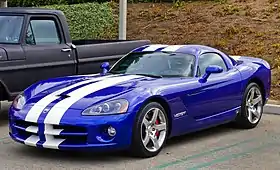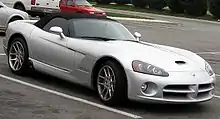Dodge Viper (ZB I)
The Dodge Viper (ZB I) is the third-generation Viper sports car, manufactured by Dodge. The third generation received a heavy design change, designed by Osamu Shikado in 1999.[2]
| Dodge Viper (ZB I) | |
|---|---|
 2006 Dodge Viper SRT-10 coupe | |
| Overview | |
| Also called | Dodge SRT-10 (UK) |
| Production | 2002–2007 |
| Model years | 2003-2006 |
| Assembly | Conner Avenue Assembly, Detroit, Michigan, United States |
| Designer |
|
| Body and chassis | |
| Class | Sports car (S) |
| Body style |
|
| Related | Bristol Fighter |
| Powertrain | |
| Engine | 8.3-liter (506.5 cu in) odd-firing Viper V10 |
| Power output |
|
| Transmission | 6-speed Tremec T56 manual |
| Dimensions | |
| Wheelbase | 2,510 mm (98.8 in) |
| Length | 4,460 mm (175.6 in) |
| Width | 1,922 mm (75.7 in) |
| Height |
|
| Curb weight |
|
| Chronology | |
| Predecessor | Dodge Viper (SR II) |
| Successor | Dodge Viper (ZB II) |
Development
The third-generation Dodge Viper was redesigned, courtesy of Osamu Shikado from Dodge's performance division, Street & Racing Technology.[2] The design took inspiration from the Viper competition coupé concept, also designed by Shikado which was unveiled two years prior as a preview for the next-generation Viper.
Production

The new Viper was introduced in 2002, named as the SRT-10, which replaced both the RT/10 and GTS models. The engine displacement was increased from 8.0 to 8.3 liters,[3] and along with other upgrades, the engine produced a maximum power output of 500 hp (373 kW; 507 PS), and 525 lb⋅ft (712 N⋅m) of torque.[4] The weight of the engine would also lose as much as 230 kg (507 lb). The chassis would become more rigid and lightweight, losing 36 kg (79 lb). A 6-speed Tremec T56 manual transmission is used to deliver all of the power to the rear wheels.
Three years later after the SRT-10 was unveiled, the coupé version of the Viper would be launched, adapting the same "double-bubble" structure as the GTS from the previous generation.[5] This model would have an increased power output of 510 hp (380 kW; 517 PS), and 535 lb⋅ft (725 N⋅m) of torque. The design of the car takes styling cues from the GTS, with the rear portion of the car adapting the tail shape, and the taillights using a design inspired by the GTS.[1]
Dodge would stop production of the Viper for 2007, in lieu of preparing the new updates for the car for the 2008 model year.
Performance
The SRT-10 can accelerate from 0–60 mph (0–97 km/h) in 3.8 seconds, 0–100 mph (0–161 km/h) in 8.36 seconds, complete the quarter mile in 11.77 seconds at 123.68 mph (199 km/h), and attain a top speed of 189.5 mph (305 km/h). The Viper also has an average slalom speed of 70.4 mph (113 km/h), a skidpad acceleration average of 1.05 g (10.3 m/s2), and a 100–0 mph (161–0 km/h) stopping distance of 274 ft (84 m).[6]
The coupé variant can accelerate from 0–60 mph (0–97 km/h) in 3.7 seconds, 0–100 mph (0–161 km/h) in 8.36 seconds, complete the quarter mile in 11.77 seconds at 123.68 mph (199 km/h), and attain a top speed of 192.6 mph (310 km/h). The coupé has an average slalom speed of 70.4 mph (113 km/h), a skidpad acceleration average of 1.05 g (10.3 m/s2), and a 100–0 mph (161–0 km/h) stopping distance of 274 ft (84 m).
References
- "2006 Dodge Viper SRT-10 Coupe". Car and Driver. Retrieved 2018-08-31.
- "2003 Dodge Viper SRT-10". Car and Driver. Retrieved 2018-08-30.
- "2003 Dodge Viper SRT10 at Top Speed". Top Speed. Retrieved 2018-08-31.
- Vance, Brian (2003-07-09). "SPEEDING SHOOTOUT: 2003 DODGE VIPER SRT-10". MotorTrend. Retrieved 2018-08-30.
- Stone, Matt (2006-01-03). "ROAD TEST: 2006 DODGE VIPER SRT10 COUPE". MotorTrend. Retrieved 2018-08-30.
- "Speeding Shootout: The Performance Tests" (online). Retrieved December 26, 2008.